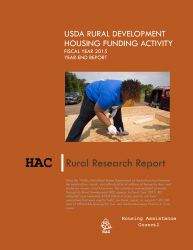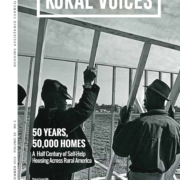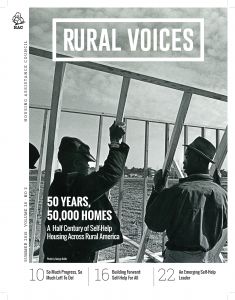HAC News Formats. pdf
July 27, 2016
Vol. 45, No. 14
• Senate passes housing act unanimously • Major party platforms approach affordable housing differently • HUD requests input on CoC distribution formula • Data and factsheets available on federal rental assistance in U.S. and each state • Early research results show housing counseling’s benefits • CRA questions and answers revised by regulators • HUD creates AFFH listserve • Brief summarizes impact of homelessness on children’s health and education • SAVE THE DATES FOR THE HAC RURAL HOUSING CONFERENCE 2016!
HAC News Formats. pdf
July 27, 2016
Vol. 45, No. 14
Senate passes housing act unanimously. On July 14 the Senate approved H.R. 3700, the Housing Opportunity Through Modernization Act, passed by the House in February (see HAC News, 2/3/16). When signed by President Obama, the bill will become law. It imposes a fee on each Section 502 guarantee, with the proceeds to be used to enhance RD’s single-family IT and automated underwriting. It also authorizes USDA to delegate Section 502 underwriting to approved lenders. Most of its provisions (summarized here by the National Low Income Housing Coalition) deal with HUD programs.
Major party platforms approach affordable housing differently. Adopted at the parties’ conventions this month, both the Republican platform and the Democratic platform support homeownership, an end to homelessness among veterans, and expansion of broadband service in rural areas. Both recognize tribal sovereignty. In other ways, the two documents are very different.
The Republican platform emphasizes the need to avoid another housing crisis. “We must scale back the federal role in the housing market, promote responsibility on the part of borrowers and lenders, and avoid future taxpayer bailouts. Reforms should provide clear and prudent underwriting standards and guidelines on predatory lending and acceptable lending practices. . . . We call for a comprehensive review of federal regulations, especially those dealing with the environment, that make it harder and more costly for Americans to rent, buy, or sell homes.” It criticizes Fannie Mae, Freddie Mac, the Dodd-Frank Act, and the Consumer Financial Protection Bureau, as well as “lending quotas to specific groups” and the Affirmatively Furthering Fair Housing regulation.
The Democratic platform cites the CFPB, as well as fair housing law and regulations, as factors contributing to the strong housing market it hopes to foster. It also supports existing federal housing programs that address both homeownership and affordable rental housing, committing to expand them and increase their funding. It specifically mentions additional monies for the National Housing Trust Fund.
To solve veteran homelessness, the Republican platform pledges better health care, including mental health care, and discusses the importance of employment. The Democratic platform calls for “robust [federal] funding” to end homelessness, mentioning families and veterans specifically.
Rural housing is not mentioned separately in either platform, but the rural economy is in both. The Republican platform strongly supports agriculture. The Democratic platform backs “a stronger rural and agricultural economy.” It also calls for “stronger agricultural worker protections including regulation of work hours, elimination of child labor, ensuring adequate housing for migrant workers, and sanitary facilities in the field.”
Native Americans are covered in both platforms. The Republican document promises to reduce federal regulations relating to Indian Country, while the Democratic commits to “strengthen the operation of tribal housing programs, and reauthorize the Indian Housing Block Grant Program. We will increase affordable and safe housing and fight to significantly reduce homelessness on and off Indian reservations, especially among Native youth and veterans.”
Both documents also address poverty. The Republican platform describes current safety net programs as “the false compassion of the status quo,” and proposes to replace them with “the dynamic compassion of work requirements in a growing economy.” It calls for “removal of structural impediments which progressives throw in the path of poor people: Over-regulation of start-up enterprises, excessive licensing requirements, [and] needless restrictions on formation of schools and day-care centers serving neighborhood families.” It urges “greater state and local responsibility for, and control over, public assistance programs.”
The Democratic platform “reaffirm[s] our commitment to eliminate poverty.” It pledges to focus on persistent poverty communities by, for example, using “the 10-20-30 model, which directs 10 percent of program funds to communities where at least 20 percent of the population has been living below the poverty line for 30 years or more.” It supports existing programs such as the Earned Income Tax Credit and the New Markets Tax Credit. It also acknowledges the “racial wealth gap” and says federal policy must help eliminate it.
HUD requests input on CoC distribution formula. Comments are due September 23 on proposed changes to the formula used to distribute Continuum of Care homeless assistance funds, and on ways to target funding to urban and rural areas most in need. Contact Norm Suchar, HUD, 202-708-4300.
Data and factsheets available on federal rental assistance in U.S. and each state. The Center on Budget and Policy Priorities offers national and state factsheets, as well as data in Excel, and includes both HUD and USDA programs. Topics include who uses and who needs rental assistance, the metro/nonmetro distribution of assisted housing by state and program, and the impacts of sequestration on HUD’s Housing Choice Voucher program.
Early research results show housing counseling’s benefits. The First-Time Homebuyer Education and Counseling Demonstration: Early Insights reports that early findings from a large HUD study are encouraging and suggest homebuyer education and counseling may lead to favorable results for first-time homebuyers in terms of mortgage literacy and preparedness, homebuyer outcomes, and loan performance. Over 5,800 prospective buyers in 28 metro areas were randomly assigned to receive remote counseling (online and telephone-based), in-person counseling (in groups and individually), or neither. HUD found that 65% of those who were offered remote education and counseling initiated services, compared to 25% of those who were offered in-person services. Participants then performed better on a mortgage literacy quiz and had higher credit scores.
CRA questions and answers revised by regulators. The federal agencies that regulate banks and savings and loans publish Q&As to help explain their Community Reinvestment Act regulations. The most recent Q&A revisions were issued July 25. Agency contacts are listed in the document.
HUD creates AFFH listserve. The new list will provide information and updates on topics directly related to Affirmatively Furthering Fair Housing, including HUD’s 2115 AFFH rule. To subscribe to this or any of HUD’s other mailing lists, visit the HUD Exchange. Additional AFFH information from HUD is also online.
Brief summarizes impact of homelessness on children’s health and education. A factsheet by the U.S. Interagency Council on Homelessness describes the short- and long-term impacts of family homelessness, along with solutions.
SAVE THE DATES FOR THE HAC RURAL HOUSING CONFERENCE 2016! This year’s national conference will be held November 29-December 2 in Washington, DC. The HAC News will announce when registration opens.





